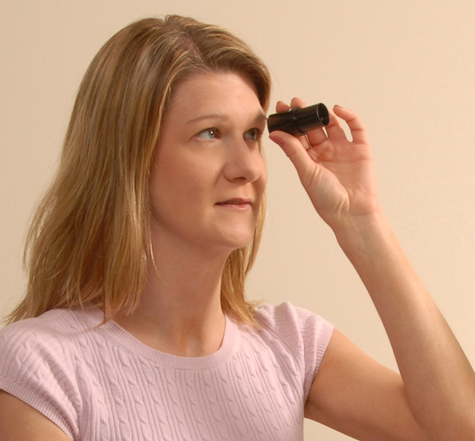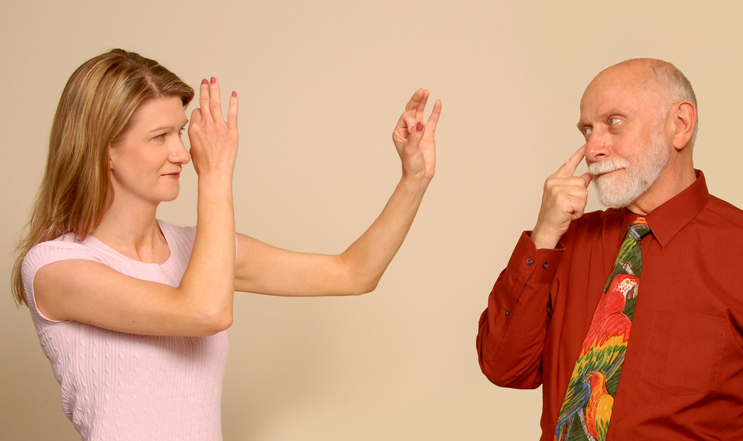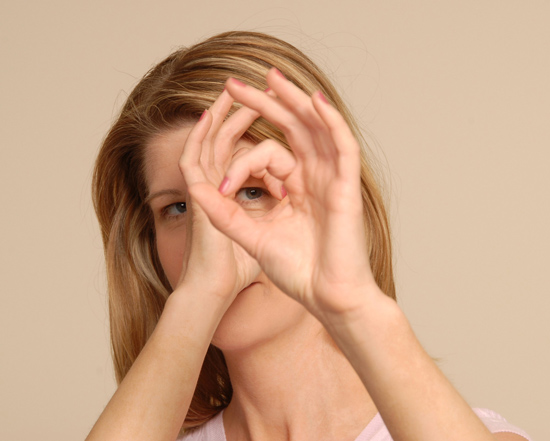Microscope Activities, 33: Eye Dominance
In the past, Hooke College of Applied Sciences offered a microscopy workshop for middle school and high school science teachers. We thought that these basic microscope techniques would be of interest not only for science teachers, but also for homeschoolers and amateur microscopists. The activities were originally designed for a Boreal/Motic monocular microscope, but the Discussion and Task sections are transferable to most microscopes. You may complete these 36 activities in consecutive order as presented in the original classroom workshop, or skip around to those you find interesting or helpful. We hope you will find these online microscope activities valuable.
EXPERIMENT 33: Eye Dominance
Goal
To determine if the right eye or the left eye is your dominant eye, and to understand the importance of eye dominance when using the microscope, especially the binocular microscope.
Level
Basic
Materials Needed
Monocular microscope, preferably with removable eyepiece
Discussion
Humans and other mammals are said to exhibit bilateral symmetry; i.e., their left and right sides are essentially mirror images. Strictly speaking, it is not so; there are small differences in the sizes and shapes of the two sides that can be demonstrated through careful measurements, and by photographic means in printing two right or two left sides of a face, for example, using half a negative flipped over. Contributing to these physical differences between the two sides is the preference that humans and other mammals show for one side of their body over the other; this is known as laterality. For example, everybody knows that there are more right-handed people in the world than left-handed people; this is referred to as handedness. Work done by Harris in 1957 and by Rengsdorff in 1967 reveal that of over 5,000 people studied, 91.5% were right-handed, 7.7% were left-handed, and 1.1% were ambidextrous. In addition to showing preference for the use of one hand over the other, however, humans and other mammals also show preference for one eye over the other, one ear over the other, one leg over the other, etc. The handedness of the dominance is not necessarily all on the same side—when the sides are mixed it is called cross dominance. A more recent study by Porac and Coren (Lateral Preferences and Human Behavior, Springer-Verlag, New York, 1981) found that amongst humans, 88.2% favor the right hand; 81.0% favor the right foot; 71.1% favor the right eye; 59.1% favor the right ear; 84% favor the same hand and foot; and 61.8% favor the same ear and eye.
We are normally not conscious of our dominances because we favor them naturally; we do not consciously decide which eye to use when looking through a telescope, or which ear to cup our hand to when listening for weak sounds, or which leg we use first to put on pants, or which leg we use when using a shovel, or kicking a ball, or operating control pedals, or using a skate board, or what our direction of rotation is in a skating spin. All of these preferences, however, are of vital importance when it comes to activities requiring aim, such as archery, rifle shooting, billiards, baseball, etc. Cross dominance complicates these issues when, for example, military rifles designed for right-hand, right-eye dominant shooters are used by cross dominant right-hand, left-eye dominant shooters. Rengstorff’s studies showed that 28.6% of the study subjects had right-hand preferences and left-eye dominance, while 3.4% had left-hand preference and right-eye dominance.
Interestingly, laterality applies to race horses, and since most race tracks are run counter-clockwise, right-side dominant horses are favored, because they take longer strides with the right foreleg, which helps them turn to the left; trainers of left-eye dominant horses often put a blinder on the horse’s left eye to encourage them to turn their head to the left. The longer stride of the dominant side is true of humans, of course, and accounts for people who are lost to walk in circles, and end up in approximately the same place from which they set out.
Most of these laterality and crossed laterality studies are conducted by psychologists and neuropsychologists, and reported in their journals. The reason for this is that it is believed that the left cerebral hemisphere of the brain controls the right side of the body (the generally stronger side), and this left hemisphere is dominant over the right because in 90-99% of all humans, the left hemisphere is the language hemisphere. Psychologists look to laterality for possible assessment of behavior characteristics.
What does eye dominance have to do with using a microscope? For users of monocular microscopes, eye dominance does not matter, because the user will automatically use their dominant eye to look into the eyepiece. With binocular microscopes, however, eye dominance is of vital importance, and ignorance of the principles involved can lead to severe eyestrain, inability to retain visualization or focus of graticules, etc., especially when the same binocular microscope is used by more than one person—this will be discussed in Experiment 34 on the adjustments of the binocular head. Our immediate job now is to learn how to determine eye dominance.
Procedure
There are several ways for the teacher to determine a student’s eye dominance, and, indeed, their own:
One way to determine eye dominance is to simply observe students using a monocular microscope; they will unconsciously use their dominant eye to look into the eyepiece. For example, Figure 33-1 is an illustration of a commemorative postage stamp in which students are depicted using monocular microscopes. Notice the two students on the right side of the stamp: the student at the far right is using her right eye, while the student next to her is using the left eye (from the engraving it is not clear which eye, if any, the boy at the far left is using). Thus, by simple observation of which eye the student unconsciously uses, eye dominance for that student is established.
Again, taking advantage of the unconscious choice of the dominant eye, the teacher may instruct the student(s) to remove the eyepiece from the microscope, and look through it while holding it up to the light to determine if there is a scale, crosshair, or pointer in it. Figure 33-2 illustrates a left-eye dominant user following this instruction; she has unconsciously shown left-eye preference; she is left-eye dominant.
This is a very certain method of determining eye dominance (refer to Figure 33-3): the teacher (right) points their index finger to their eye (they are likely to point to their dominant eye), and asks the student (left) to form two circles using the index finger and thumb of both hands (“OK” sign), and, WITH BOTH EYES OPEN pretending they are using a telescope, holding one circle at their eye, and the other much farther away, and look at the eye that the teacher is pointing his finger to. Again, the student will unconsciously bring the “telescope” up to their dominant eye (in the illustrated case, the left eye), and the teacher’s view of the student (Figure 33-4) will leave no doubt that this student is left-eye dominant.
Task
Determine your eye dominance, and that of friends and acquaintances around you; then determine the dominant eye of your students using one or more of the methods described in the Procedure section




Comments
add comment